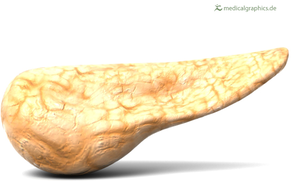Difference between revisions of "Pancreas"
(→The Pancreas as an Endocrine Gland) |
|||
| Line 13: | Line 13: | ||
: In [[Type 1 Diabetes]] the [[pancreas]] is damaged and cannot produce [[insulin]] to regulate [[Blood Glucose|blood glucose]] levels. | : In [[Type 1 Diabetes]] the [[pancreas]] is damaged and cannot produce [[insulin]] to regulate [[Blood Glucose|blood glucose]] levels. | ||
: In [[Type 2 Diabetes]] the [[pancreas]] may be overworked having to produce much more [[insulin]] than it would in a healthy [[animal]]. | : In [[Type 2 Diabetes]] the [[pancreas]] may be overworked having to produce much more [[insulin]] than it would in a healthy [[animal]]. | ||
| + | |||
| + | ===Extra Information=== | ||
| + | {{#ev:youtube|https://www.youtube.com/watch?v=8dgoeYPoE-0}} | ||
Revision as of 17:23, 20 April 2019
Contents
Key Stage 4
Meaning

A computer generated image of a pancreas.
The pancreas is an organ in the Digestive System and an endocrine gland.
The Pancreas and Digestion
- The pancreas produces digestive enzymes including pancreatic amylase, trypsin (which is a type of protease and lipase.
- The digestive enzymes are passed down the pancreatic duct which joins with the bile duct before arriving in the Small Intestine.
The Pancreas as an Endocrine Gland
- The pancreas secretes the hormones insulin and glucagon to regulate blood glucose levels.
- The liver is a target organ for the hormone glucagon.
- In Type 1 Diabetes the pancreas is damaged and cannot produce insulin to regulate blood glucose levels.
- In Type 2 Diabetes the pancreas may be overworked having to produce much more insulin than it would in a healthy animal.